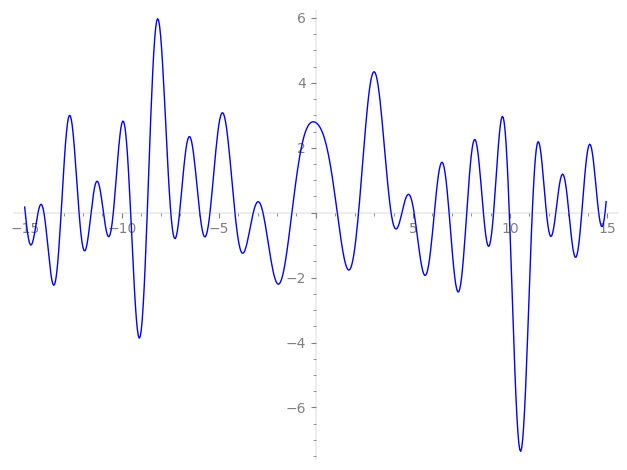| L(s) = 1 | + (0.866 − 0.5i)2-s + (0.499 − 0.866i)4-s + 3.18i·5-s + (0.866 + 0.5i)7-s − 0.999i·8-s + (1.59 + 2.75i)10-s + (3.49 − 2.01i)11-s + (−0.333 − 3.59i)13-s + 0.999·14-s + (−0.5 − 0.866i)16-s + (1.23 − 2.13i)17-s + (0.595 + 0.343i)19-s + (2.75 + 1.59i)20-s + (2.01 − 3.49i)22-s + (2.89 + 5.01i)23-s + ⋯ |
| L(s) = 1 | + (0.612 − 0.353i)2-s + (0.249 − 0.433i)4-s + 1.42i·5-s + (0.327 + 0.188i)7-s − 0.353i·8-s + (0.503 + 0.871i)10-s + (1.05 − 0.608i)11-s + (−0.0925 − 0.995i)13-s + 0.267·14-s + (−0.125 − 0.216i)16-s + (0.298 − 0.517i)17-s + (0.136 + 0.0788i)19-s + (0.616 + 0.355i)20-s + (0.429 − 0.744i)22-s + (0.603 + 1.04i)23-s + ⋯ |
Λ(s)=(=(1638s/2ΓC(s)L(s)(0.996−0.0797i)Λ(2−s)
Λ(s)=(=(1638s/2ΓC(s+1/2)L(s)(0.996−0.0797i)Λ(1−s)
| Degree: |
2 |
| Conductor: |
1638
= 2⋅32⋅7⋅13
|
| Sign: |
0.996−0.0797i
|
| Analytic conductor: |
13.0794 |
| Root analytic conductor: |
3.61655 |
| Motivic weight: |
1 |
| Rational: |
no |
| Arithmetic: |
yes |
| Character: |
χ1638(127,⋅)
|
| Primitive: |
yes
|
| Self-dual: |
no
|
| Analytic rank: |
0
|
| Selberg data: |
(2, 1638, ( :1/2), 0.996−0.0797i)
|
Particular Values
| L(1) |
≈ |
2.776393405 |
| L(21) |
≈ |
2.776393405 |
| L(23) |
|
not available |
| L(1) |
|
not available |
L(s)=p∏Fp(p−s)−1 | p | Fp(T) |
|---|
| bad | 2 | 1+(−0.866+0.5i)T |
| 3 | 1 |
| 7 | 1+(−0.866−0.5i)T |
| 13 | 1+(0.333+3.59i)T |
| good | 5 | 1−3.18iT−5T2 |
| 11 | 1+(−3.49+2.01i)T+(5.5−9.52i)T2 |
| 17 | 1+(−1.23+2.13i)T+(−8.5−14.7i)T2 |
| 19 | 1+(−0.595−0.343i)T+(9.5+16.4i)T2 |
| 23 | 1+(−2.89−5.01i)T+(−11.5+19.9i)T2 |
| 29 | 1+(−0.940−1.62i)T+(−14.5+25.1i)T2 |
| 31 | 1−4.17iT−31T2 |
| 37 | 1+(0.322−0.186i)T+(18.5−32.0i)T2 |
| 41 | 1+(−6.83+3.94i)T+(20.5−35.5i)T2 |
| 43 | 1+(−2.48+4.30i)T+(−21.5−37.2i)T2 |
| 47 | 1−11.8iT−47T2 |
| 53 | 1−9.59T+53T2 |
| 59 | 1+(−2.23−1.28i)T+(29.5+51.0i)T2 |
| 61 | 1+(6.79−11.7i)T+(−30.5−52.8i)T2 |
| 67 | 1+(−7.46+4.30i)T+(33.5−58.0i)T2 |
| 71 | 1+(9.08+5.24i)T+(35.5+61.4i)T2 |
| 73 | 1−16.5iT−73T2 |
| 79 | 1+13.2T+79T2 |
| 83 | 1+9.39iT−83T2 |
| 89 | 1+(−7.55+4.36i)T+(44.5−77.0i)T2 |
| 97 | 1+(5.32+3.07i)T+(48.5+84.0i)T2 |
| show more | |
| show less | |
L(s)=p∏ j=1∏2(1−αj,pp−s)−1
Imaginary part of the first few zeros on the critical line
−9.542151954648198413821483467127, −8.687364622808177416767319622277, −7.47427107870414629557402156905, −7.02166407489691021968660557827, −5.98113535034032303715034547849, −5.45644431816364556029486624353, −4.17108696034467267694017045193, −3.22598257254841351757621455416, −2.72639865812474435270555542153, −1.23604589551708631757880039394,
1.10004135052111374271776522232, 2.19634750366983714545599702794, 3.87236000021475097725937572961, 4.43221314079495573877756051133, 5.05706809357876312300273059686, 6.10191277539369852629920919059, 6.86037232567704664410831981590, 7.76890683837375474907772867511, 8.628335844473711346460086978250, 9.151350746795450580062187841449

